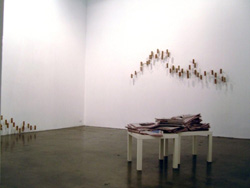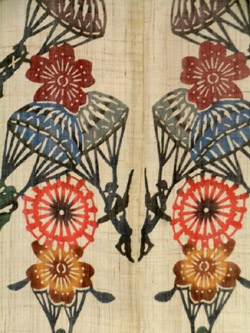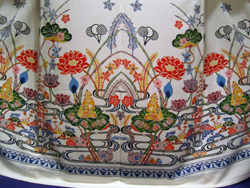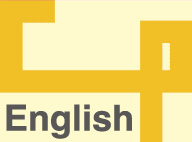Yuken Teruya (artist, born 1973 in Okinawa, based in New York)
Okabe: So you’re collecting toilet rolls.
Teruya: Japanese rolls are fancy, but American one’s are better to make beautiful branches.
Okabe: I think American rolls are bigger than Japanese one’s.
Teruya: Most of the American rolls are like that. I have to be careful because each branch is different and there isn’t actually any straight line in it. Well, it’s just the contrast of how strong I cut the paper since the paper is really thick, but these days I believe that it’s these slight differences that make the big difference in the end.
Okabe: Why is it a tree? Your works in Yokohama Triennale in 2005 were also silhouettes of trees cut out from thin paper bags. Paper is made from pulp that comes from woods. So does it mean that you’re reversing the paper?
Teruya: You’re right. I’m also trying to practically show that although paper and tree are different materials, the way how paper holds itself up with its own strength is actually similar to that of a real tree. Which means, the paper is still the tree itself.
Okabe: It sounds like as if paper possesses a memory of tree inside it like the DNA.
Teruya: And the strength itself is also the same as the real tree. I make the silhouette of trees to show how the energy of tree still remains inside the paper.

Lost and found, installation
©Teruya Yuken

Lost and found
©Teruya Yuken
Okabe: I heard that you’re busy working on your works for the solo museum presentation at Asia Society, which begins in the spring of 2007.
Teruya: I’m mainly working on Bingata-dyed kimono. I design the patterns and send it to the stencil studio in Okinawa to have the stencil cut. The drawing on the stencil is almost done and they’ve already started cutting it.
Okabe: It was very shocking to see such things like tanks and soldiers among the Okinawa’s traditional motif in your Bingata kimono “You-I, You-I”, which you took the encourage award of VOCA exhibition in 2002. How did you get to know the craftsmen?

「You-I, You-I」 2002 Detail
© Teruya Yuken
Teruya: They seem to be remote relatives of mine. When I made this, I was refused to collaborate with a university, and three studios rejected my proposal. People in Okinawa said my concept and the idea to use the technique of crafts for modern art were ridiculous at first. Also, talking about US military bases was a taboo in those days.
Okabe: Did you have any arguments with the craftsmen of Bingata when you started? I guess you didn’t know how much they were skilled at first.
Teruya: Oh yes. We had different views and they had their own taste. What really matters to craftsmen is the actual work, not the concept. So they think what they made is theirs and it’s OK to use it in their other works. I really had difficulty with these kinds of differences and I discussed with them by quoting the history of modern art. I had to think hard.

「free fish,kimono」 ditail
© Teruya Yuken

「free fish,kimono」 2007
Asian Society,New York
© Teruya Yuken
Okabe: You projected the collection of Asia Society, which is based on Rockefeller collection of Asian Art, onto the patterns of kimono.
Teruya: Yes, I considered the fact that there were trades between the Ming dynasty and the Ryukyu Kingdom and that they had close relationship. This idea started out from wondering why the design and the colors of this Chinese jar looked similar to that of Bingata in Okinawa. I also liked how Bingata accepts foreign cultures and makes it into patterns. Rockefeller basically introduced the Asian art to the western culture in the form of collection and I wanted to reflect that intention with history and art by putting it into patterns of Bingata.
Okabe: Your main theme is that painting of a golden fish on the Chinese jar.
Teruya: Fish is a symbol of good wealth and the jar was meant to be a lucky ornament. I titled my exhibition “free fish” and I want to create the fish swimming slowly in the center of exhibiting place, not just in the patterns of kimono. Actually, I want the patterns to release the golden fish from concepts. I hope visitors would enjoy the title “ free fish” in terms of “releasing”.
Okabe: At your first kimono, which you focused on the US military base, you had the patterns that described the events completely fit into the structure of kimono. So I guess that’s why you’re trying to release the golden fish this time.
Teruya: Well originally, Buddhist images were gods and jars were used practically. However, now that they’ve become a part of collection in museums, it’s forbidden to even touch it. So I wanted to at least restore the patterns to how it had been. Or by making the collection into Bingata, I thought I could make good use of its original value in a way that I understood -or maybe misunderstood. I think this can show another side of “free fish”.
Okabe: You give importance to what Okinawa has been through and some kind of symbolism that Okinawa has.
Teruya: I think it’s important to introduce the views from outside to Okinawa, since people tend to get blind if they just stay inside. It’s important to have a local like me to make remarks from a standpoint of outside Okinawa. Otherwise, it would be hard to change the minds of other locals inside. I especially care about this point when I have an exhibition focusing on Okinawa in Japan.
Okabe: Okinawa’s infrastructure may improve because Okinawa Prefectural Art Museum is going to be established and there will be Modern art section in it.
Teruya: Yes, we all must develop it well together.
Okabe: Do you have any plans for your next work?
Teruya: I’m interested in making a public art. I’m thinking of a monument that’s like a sail of a sailboat, which turns the island of Okinawa into a ship. It should be really big and high. I want it to visualize the wind by using cloth.
Okabe: I didn’t see any landmarks when I visited the reclaimed land where the museum is going to be built.
Teruya: When I first went there, everything looked the same and I wasn’t exactly sure where I was going. I want the people who actually live there to decide the direction of this “island”. I don’t want to see the politicians in power or people vacating their lands because of big companies buying it. I want the people who really think about this “island” to manage this place.
Okabe: Maybe something huge would be good because you’ve been working on a small scale like paper bags and toilet rolls so far. It might be interesting to work on a large scale next.
Teruya: Something that gives people hope that they can also lead the island. It would be nice if people could climb up and overlook the whole island.
Okabe: Then, it would be an architectural monument.
Teruya: I’ve had this idea of sailboat for two years. I’m now wondering stuffs like whether an advice from an architect, although I’ve never worked with them, would help me advance further. At any rate, I’m trying to make a direction.
(At the studio of Yuken Teruya in Brooklyn, New York, January 18th, 2007, translated by Akihiko Sugiura)
照屋勇賢(アーティスト、1973年沖縄県生まれ、ニューヨークで活動)
岡部あおみ: トイレットペーパーの芯を集めているんですね。
照屋勇賢: これはアメリカのロールで、日本の芯はファンシーですが、これだとすごくきれいな枝が作れます。
岡部: アメリカの芯は、太さも違いますね。
照屋: 芯の種類はこういうタイプが多いです。でも、枝からすると直線も直線 じゃなく、表情があって、それを意識していかないと難しい。本当に紙が硬いので、その時に力が入るか入らないかの差ですけど、それが一つ一つ最終的には大きな違いを出す作品じゃないかと最近思います。
岡部: でも何で、木なんでしょう。2005年の横浜トリエンナーレに出品なさっていたのは、薄い紙袋を切って作った、やはり木でしたが。紙という素材がパルプと いう元が木だったから元に戻すという意味があるのかしら。
照屋: それもあるし、実践的にやろうとしていることは、紙と木は別素材だけども、紙が支えてる力があって、この力の伝わり方が、実際の木と似ているんですよね。ということは、これそのものが、まだまだ木そのものであるということになります。
岡部: DNAみたいな感じで記憶を残しているという風にもとれますね。
照屋: あと力そのものも、木と一緒で、木の力がまだまだ残ってることを伝えるために、あえて木の形を作っています。
岡部: 2007年春に始まるアジアン・ソサイエティの個展に出品する作品を、現在、制作なさっていてお忙しいんですね。
照屋: 主となる新作は着物で、紅型の下絵はほぼ上がっていて、型彫りが始まっています。ぼくが下書きを描いて、その情報を沖縄の型を作る工房に送って、彫ってもらうんです。
岡部: 2002年の「VOCA」展で奨励賞になった紅型の着物 『結ーい、結ーい』で、沖縄の伝統的なモチーフに戦車とか兵士が混入していて、すごく刺激的でし た。その工房の職人さんとは どういう風にお知り合いになったのでしょう。
照屋: 遠い親戚に当たるみたいです。この時は、協力を頼んだ大学にも断られて、工房にも三箇所断られ てます。沖縄では最初、作品の内容と、現代美術として工芸の技術を使うことがとんでもないという反応だったのと、当時は基地の内容がタブーでした。
岡部: 初めての時は紅型職人さんたちの技量もわからなかったでしょうが、最初はぶつかったこともあったのでは?
照屋: ありますね。コンセプトの違いとか、彼らのテイストもあったし。工芸の方達の世界は、物の勝負です。コンセプトで はなく、自分が作った型なのだから自分の作品にも使って良いだろうという話になりがちです。そこら辺で、僕自身も実際経験して考えて作っていかなきゃいけ ないところもあるし、今までの現代美術のプロセスみたいのを引用して説得したり、交渉したりして、その辺は難しいと思いました。
岡部: ロックフェラーの東洋美術コレクションが核となったアジアンソサエティの収蔵品のモチーフを、今回は着物の柄に落とし込んでいるんですね。
照屋: はい。最初この中国の壷の色や構成の仕方が沖縄の紅型に似てると思って、そこから入っていったんですけど、当時、明と琉球は交易もあ り、国家間でも近い関係だったので、それを意識した形での切り口です。紅型はいろんな異文化を取り込んで模様にするところも好きでした。ロックフェラーも 基本的にアジア美術をコレクションという形で西洋に紹介していったわけですし、それを紅型で、歴史や美術でそうした意思を反映した形で模様にしてしまおう と思ったん
岡部: あの中国の壺の絵にある金魚が中心的なモチーフですね。
照屋: 中国では魚はいい意味での富の象徴で、縁起のいい置物として作られていたので、展覧会のタイトルを「フリーフィッシュ」にして、金魚の着 物の柄だけではなく、展覧会の空間の真ん中でゆったりと泳いでる姿を作りたいんです。着物の柄では、どちらかと言うと世界観から金魚へ逃げる、開放される柄になればと思っていて、「リリースする」という意味での「フリーフィッ シュ」というタイトルを、楽しく感じてもらえればいいと思います。
岡部: 沖縄の基地を主題にした一作目の着物には、出来事としての模様が、着物というフレームに完全にはめ込まれていましたから、今回は、着物の金魚を逃がす方図になるということですね。
照屋: 元々コレクションになる前は仏像は神様であったり、壷はちゃんと用途として使われてたり していたと思うんですけど、美術館のコレクションになった今はもう、触ることすらできない。せめて、柄だけでも本来の生き生きした形に戻してあげたり、紅 型に取り込むことで、本来彼らが持っていた、別の用途を、僕が勘違いした生かし方でもいいから取り込んで、別の意味での「フリーフィッシュ」という見方も 更にできるんじゃないかと考えたんですね。
岡部: 照屋さんは沖縄が辿ってきた歴史や沖縄のある種の象徴性を大事にしていますね。
照屋: 沖縄には、外からの視線を持っていくのが大切だと思うんです。内側にいると見えなくなっていくので。外からの視線で、僕のように地元 の人間が発言することが大切だと思うんです。じゃないと、内側の人たちの考えはなかなか動かないと思う。沖縄で、または日本での展覧会で沖縄のことを考え る時には、とくに意識しますね。
岡部: これから沖縄の県立美術館も設立され、現代美術部門も新設されるようだから、沖縄のインフラも改良される可能性がありますね。
照屋: そうですね。みんなでちゃんと育てていかないといけないです。
岡部: また新しい作品を作る予定なのですか。
照屋: パブリックアートをしたいんですけどね。アイ デアとしては沖縄の島が船になるイメージで、帆船の帆みたいなもの、とにかく大きい、高い物で、布で風を意識できるようなモニュメントを考えているところ です。
岡部: 行ってみたことがあるのですが、ランドマークがないですね。
照屋:最初に足を踏み入れたときに、どこも一緒に見えて、西に向かっているか東に向かっているかわからなかった。あそこに住んでいる人達だけでちゃんとこの「島」の方向性を決めて ほしいんです。政治家の力とか大企業が買うから土地を明け渡すんじゃなく、この「島」を考えていく人たちできちんと動かして欲しい。
岡部: 巨大な物が良いかもしれませんね。今までは小さな紙袋とかトイレットペーパーの芯とか、極小の世界、ミクロをやっていたから、今度は巨大なマクロにしたら面白いかもしれない。
照屋: 自分もリーダーになれるという希望を与えるもの。できれば登らせたいですね。「島」を見下ろして。
岡部: そうしたら、建築的モニュメントになりますね。
照屋: この帆船のアイデアは、2年ぐらい前からあって、建築家と今まで仕事をしたことがないけれど、建築家の意見を聞くことでまた更に先に進めるかもしれないな どと、悶々と考えているところです。とにかく作っていきたいのは、方角ですね。
(2007年1月18日、ニューヨーク、ブルックリンにある照屋勇賢のスタジオ)
